Understanding Behavior Through Reinforcement
Behavior modification hinges on understanding how consequences influence actions. At the heart of this is reinforcement – the process by which behaviors become more likely to recur when followed by favorable outcomes. This foundational principle underpins various therapies and educational strategies, playing a pivotal role especially in autism interventions like Applied Behavior Analysis (ABA). This article explores how different reinforcement schedules influence the learning and sustainability of behaviors, offering a roadmap to effective behavior modification.
Foundations of Behavior Modification: The Legacy of Operant Conditioning

What is operant conditioning and B.F. Skinner's contributions?
Operant conditioning is a fundamental theory in behavioral psychology developed by B.F. Skinner. It explains how behaviors can be shaped and modified through consequences. Skinner introduced the idea that behaviors followed by favorable outcomes are more likely to recur, laying the groundwork for modern behavior modification techniques.
What is reinforcement and its types?
Reinforcement is the process of encouraging a behavior by following it with a consequence that increases its likelihood of happening again. There are two main types:
- Positive reinforcement: Adding a pleasant stimulus after a behavior (e.g., praise or rewards).
- Negative reinforcement: Removing an unpleasant stimulus following a behavior (e.g., stopping a loud noise).
Reinforcers themselves can be primary, such as food and water fulfilling biological needs, or secondary, like money and verbal praise, which are learned rewards.
How does reinforcement apply in behavior modification?
Behavior modification uses these concepts to encourage desirable actions and reduce unwanted ones. By systematically applying reinforcement, practitioners help shape new behaviors over time, employing various reinforcement schedules to optimize learning and persistence.
What is Applied Behavior Analysis (ABA) therapy and how does it help individuals with autism?
Applied Behavior Analysis (ABA) therapy uses operant conditioning principles to support individuals with autism spectrum disorder (ASD). Through detailed behavior analysis and structured reinforcement, ABA helps improve communication, social skills, and daily living abilities. Customized ABA programs use reinforcement strategies to promote meaningful learning experiences, making them effective for shaping and maintaining positive behaviors in children with autism.
The Science Behind Reinforcement: Positive and Negative Influences
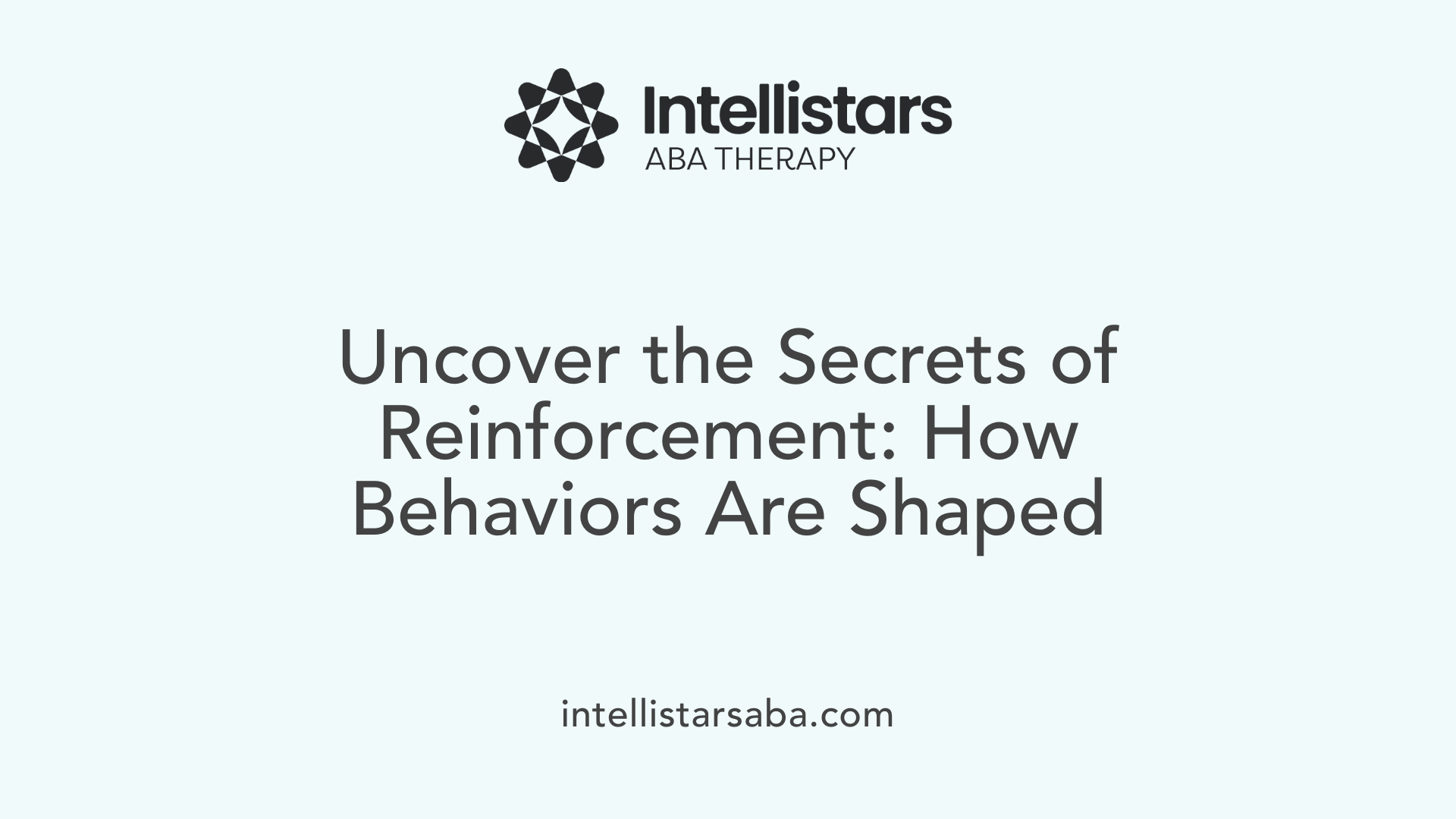
What is Positive and Negative Reinforcement?
Reinforcement is a fundamental concept in behavioral psychology that aims to increase the likelihood of a behavior recurring. It comes in two forms: positive and negative reinforcement. Positive reinforcement involves adding a pleasant stimulus following a behavior, such as offering praise or a reward, encouraging the behavior to happen more often. Negative reinforcement, on the other hand, removes an unpleasant stimulus after a behavior, such as stopping a loud noise when a desired action occurs, which also strengthens the behavior.
What Are Primary and Secondary Reinforcers?
Reinforcers can be categorized based on whether they fulfill biological needs or learned rewards. Primary reinforcers satisfy innate biological necessities, like food, water, or relief from pain. These are naturally rewarding and do not require learning to be effective. Secondary reinforcers, however, gain their value through association with primary reinforcers. Examples include money, praise, and tokens, which become motivating after being linked to basic needs or pleasurable experiences.
How Are These Concepts Used in ABA Therapy?
Applied Behavior Analysis (ABA) therapy extensively uses these reinforcement principles to shape and improve socially significant behaviors, especially with individuals affected by autism. Positive reinforcement is a cornerstone technique in ABA, where rewarding appropriate actions increases their frequency. Reinforcers selected in ABA can be either primary (like preferred snacks) or secondary (such as verbal praise or tokens that can later be exchanged for a reward).
Many ABA strategies, such as prompting, fading, and behavior chaining, rely on reinforcement to teach new skills gradually and maintain them over time. By carefully choosing when and how to apply reinforcement—whether positive or negative, primary or secondary—therapists enhance learning efficiency and behavioral outcomes. This personalized approach ensures meaningful progress tailored to each individual's unique needs.
Reinforcement Schedules: The Blueprint for Behavior Change
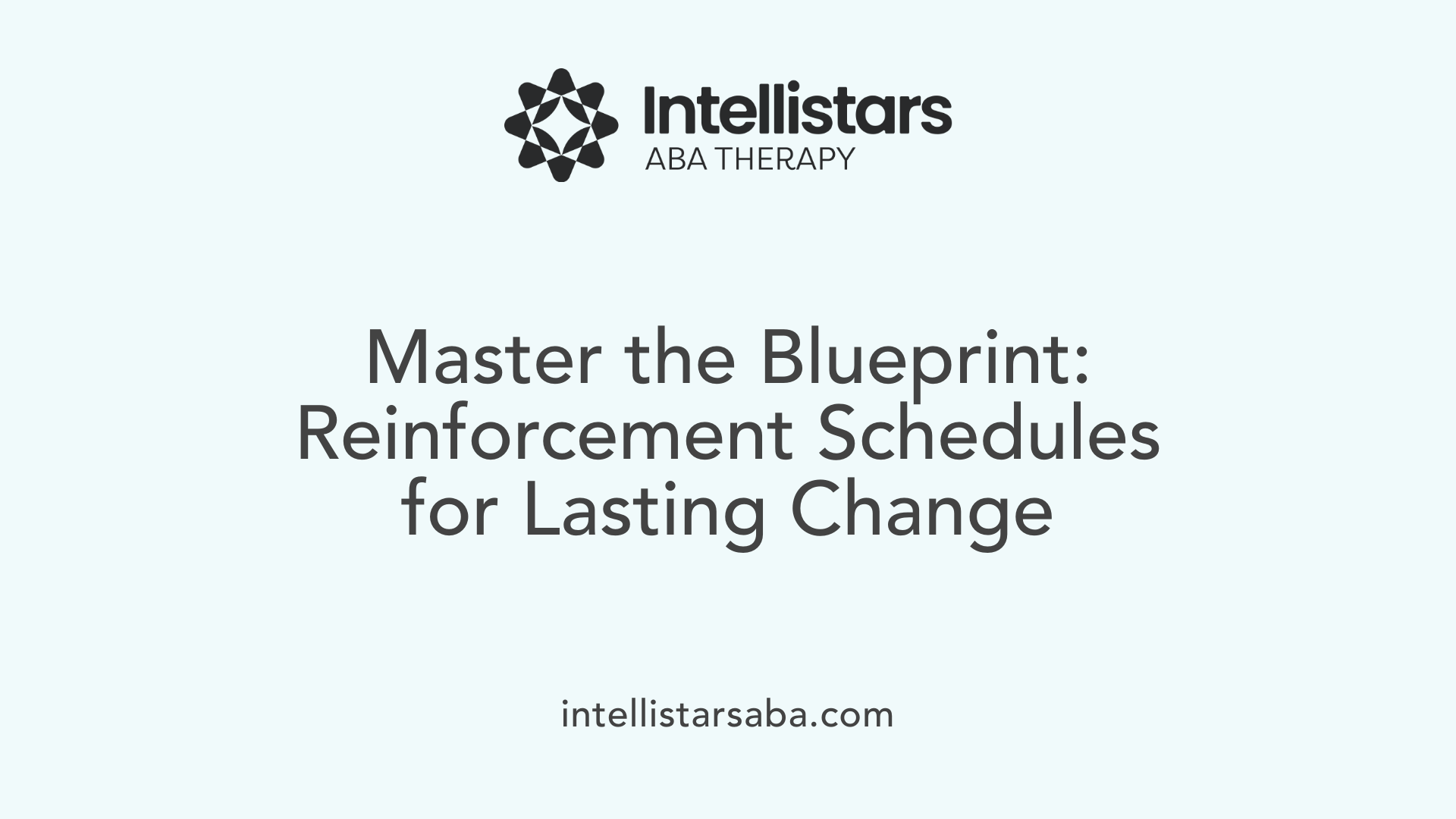
What Are Reinforcement Schedules?
Reinforcement schedules are the specific rules or plans that dictate when and how often a behavior is rewarded. These schedules play a crucial role in shaping how behaviors are acquired and maintained. By controlling the timing and frequency of reinforcement, they influence the likelihood that a behavior will happen again.
Continuous vs. Intermittent Reinforcement
There are two main types of reinforcement schedules: continuous and intermittent. Continuous reinforcement involves providing a reward every time the desired behavior occurs. This method is highly effective during the initial learning phase because it clearly links the behavior to the reward, making it easy for a learner to understand what is expected.
Intermittent reinforcement, on the other hand, rewards the behavior only some of the time. This includes fixed and variable schedules based on specific numbers of responses or periods of time. Intermittent reinforcement is key to maintaining behaviors in the long run because it tends to produce more persistent behavior that is resistant to extinction.
Impact on Behavior Acquisition and Maintenance
Using continuous reinforcement in early learning helps individuals quickly acquire new skills or behaviors. However, if the reinforcement is suddenly stopped, behaviors learned this way may fade quickly, a process called extinction.
Intermittent schedules—such as fixed ratio, variable ratio, fixed interval, and variable interval—are more effective for sustaining behavior over time. For example, variable ratio schedules, where reinforcement happens after an unpredictable number of responses, produce highly steady and persistent behavior patterns. This method is notably used in contexts requiring long-term motivation, like gambling.
Applied Behavior Analysis (ABA) and Autism
Applied Behavior Analysis (ABA) therapy is a powerful example of how reinforcement schedules are practically applied. ABA uses these schedules to decide when and how frequently to reinforce behaviors in individuals with autism spectrum disorder. Continuous reinforcement ensures rapid learning of new skills, while carefully designed intermittent reinforcement schedules help maintain these skills over time, making ABA a highly effective therapeutic strategy.
Continuous Reinforcement: Establishing New Behaviors
What is Continuous Reinforcement?
Continuous reinforcement is a schedule of reinforcement where every correct response or behavior is rewarded. This approach ensures that each time a desired behavior occurs, it immediately receives reinforcement, which helps to strongly connect the behavior with positive outcomes.
Why Is Continuous Reinforcement Effective in Initial Learning?
Because reinforcement is provided every time the behavior is performed, continuous reinforcement is especially effective during the early stages of learning new behaviors. It helps individuals quickly associate the behavior with its consequence, speeding up the acquisition and establishment of the new behavior.
What Are the Limitations of Continuous Reinforcement?
While continuous reinforcement establishes new behaviors efficiently, it does have limitations. Since the reinforcement is delivered every time, it may not be practical or sustainable in real-life settings where constant reward provision isn't feasible.
What Is the Risk of Extinction With Continuous Reinforcement?
A significant drawback of continuous reinforcement is the higher risk of extinction. If reinforcement suddenly stops, behavior learned under continuous reinforcement tends to decrease rapidly because the individual has come to expect a reward every time. This contrasts with intermittent reinforcement schedules that often produce more persistent behavior.
In summary, continuous reinforcement is a powerful tool for initial learning by providing immediate and consistent rewards. However, transitioning to intermittent schedules is crucial for maintaining long-term behavior and preventing quick extinction.
Fixed and Variable Interval Schedules: Timing Matters
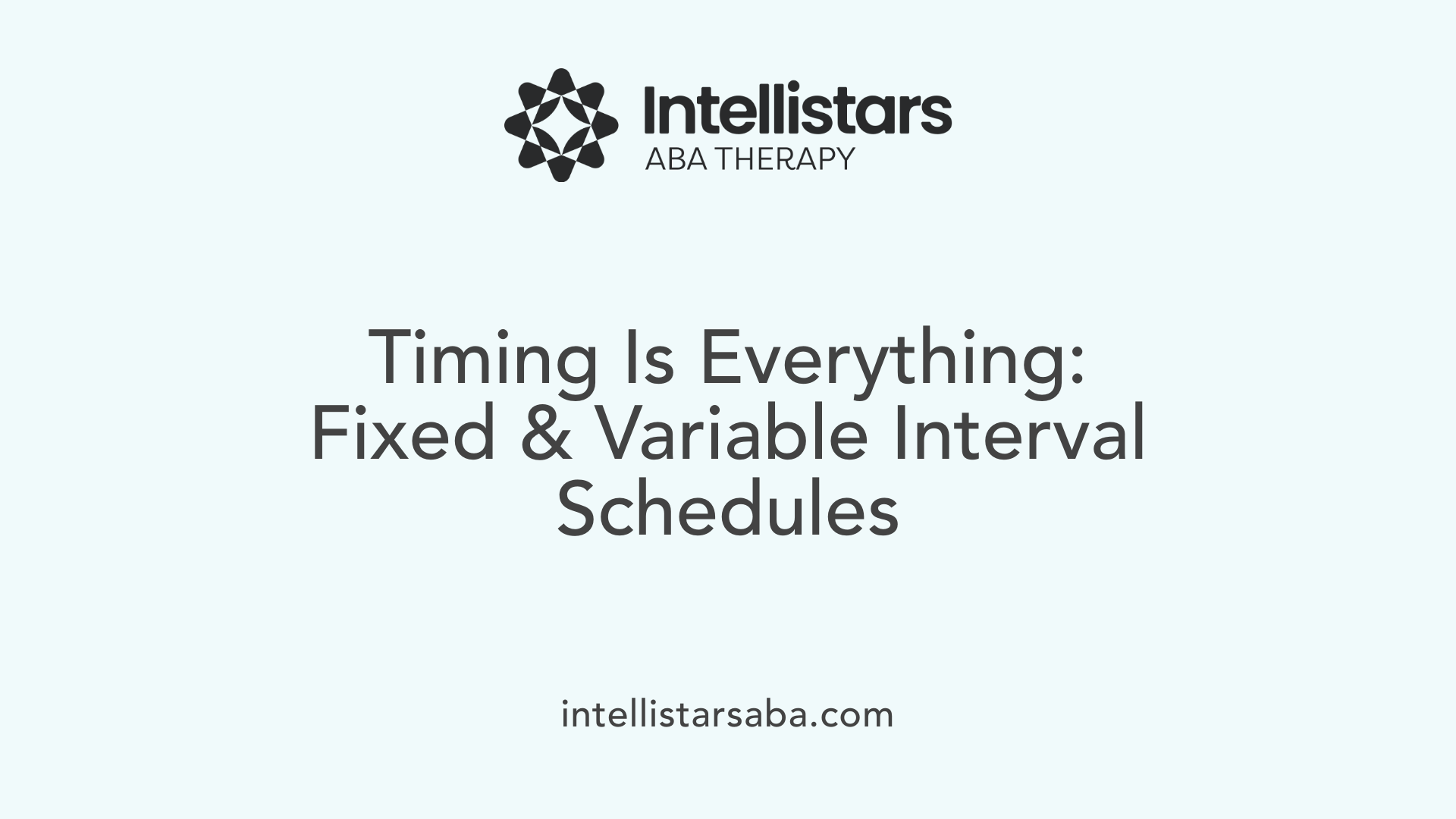
What is a Fixed Interval Schedule?
A fixed interval (FI) schedule delivers reinforcement after a specified, constant amount of time has passed, assuming the target behavior has occurred. For example, a student might receive praise every 10 minutes if they stay on task.
This schedule often leads to a "scalloped" response pattern. Behavior increases as the time for reinforcement nears and drops right after it is delivered. This means individuals may pause after getting the reward but become more active when another reinforcement is imminent.
What Defines a Variable Interval Schedule?
Variable interval (VI) schedules administer reinforcement after unpredictable amounts of time, as long as the behavior happens. This unpredictability discourages pauses and encourages consistent engagement because the subject cannot predict exactly when the next reward will come.
How Do These Schedules Affect Behavior Response Patterns?
Fixed interval schedules tend to produce a rhythmic pattern: a lull in responding after reinforcement, followed by increasing efforts as the next reinforcement time approaches. Variable interval schedules, on the other hand, encourage steady and persistent behavior with minimal pauses.
Why Is Timing Important in Maintaining Steady Behavior?
Timing affects motivation. Fixed intervals can create bursts of activity near reinforcement times but might discourage continuous effort. Variable intervals foster more steady, sustained behaviors beneficial for long-term habits.
These characteristics make interval schedules valuable tools in areas like education and Applied Behavior Analysis (ABA), where shaping and maintaining desired behaviors over time are critical.
Fixed and Variable Ratio Schedules: Response-Based Reinforcement
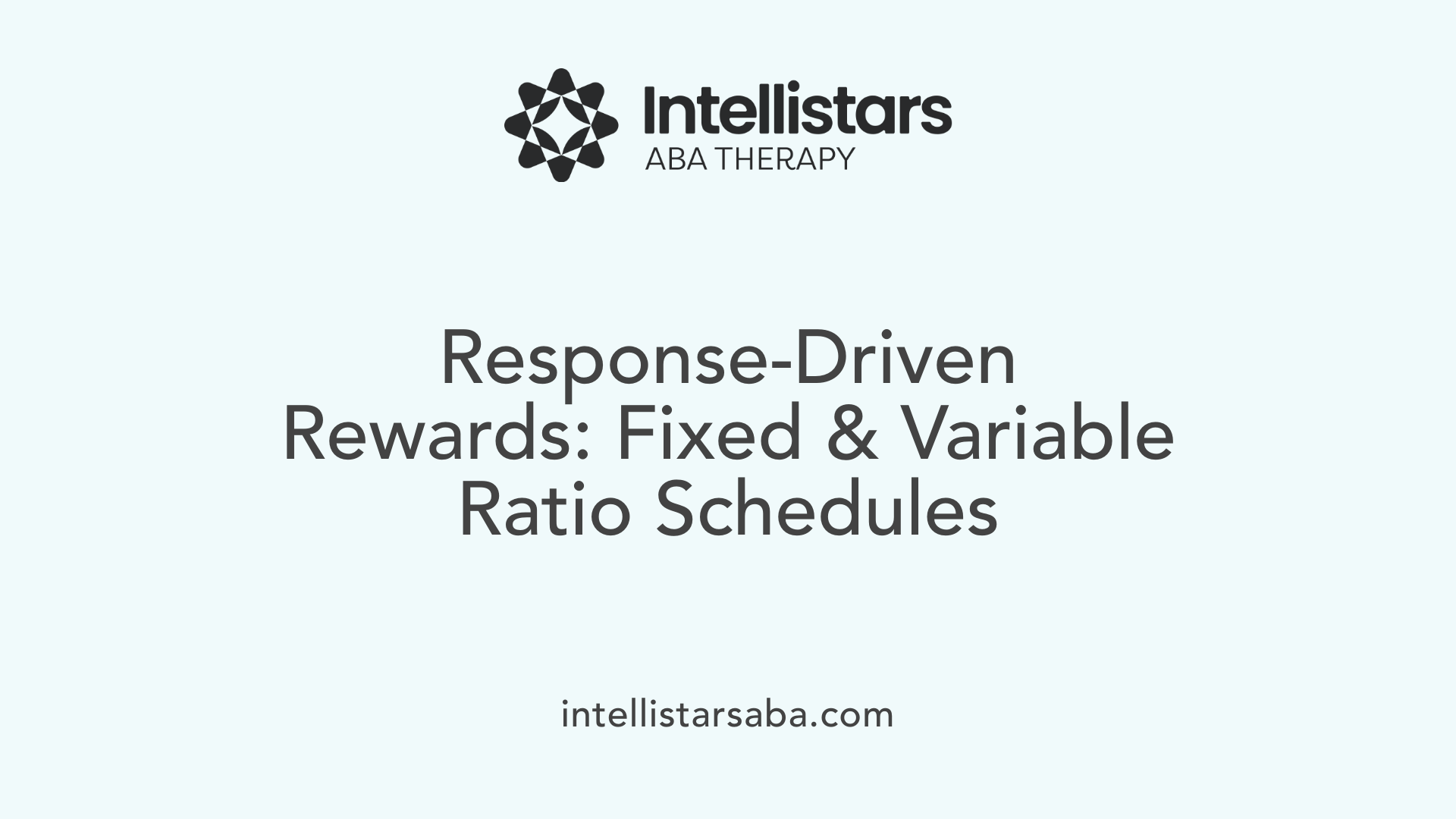
What is a Fixed Ratio Schedule?
Fixed ratio (FR) schedules deliver reinforcement after a set number of responses. For instance, a reward might be given every third correct behavior. This schedule tends to produce a high rate of responding because the individual learns that multiple responses lead to a reward. However, it often results in a pattern where there is a burst of rapid responses followed by a pause right after the reinforcement, known as a post-reinforcement pause.
How Does a Variable Ratio Schedule Work?
Variable ratio (VR) schedules are less predictable. Reinforcement is provided after a varying number of responses, which makes it uncertain when the next reward will come. This unpredictability encourages consistent and steady responding because the individual cannot predict exactly when the reinforcement will occur. VR schedules are known for producing high and persistent rates of behavior. This schedule is famously linked with gambling behaviors, where the uncertainty keeps individuals engaged.
Effects on Response Rates
Both FR and VR schedules produce high response rates, but the patterns differ. FR schedules create rapid responding with occasional pauses after reinforcement. VR schedules maintain consistent and steady responses without significant breaks due to the unpredictable nature of reinforcement timing.
Why Do Behaviors Persist Longer Under Variable Ratio Schedules?
Behavior under VR schedules is highly persistent even when reinforcement is stopped because the individual has learned that rewards come unpredictably. This persistence contrasts with FR schedules, where behaviors may decline more quickly if reinforcement ceases, partly because the pattern includes predictable pauses.
Together, FR and VR schedules offer powerful tools in behavior modification by controlling how often reinforcement follows responses, thereby shaping how quickly and persistently behaviors occur.
Implementing Reinforcement Schedules in ABA Therapy for Autism
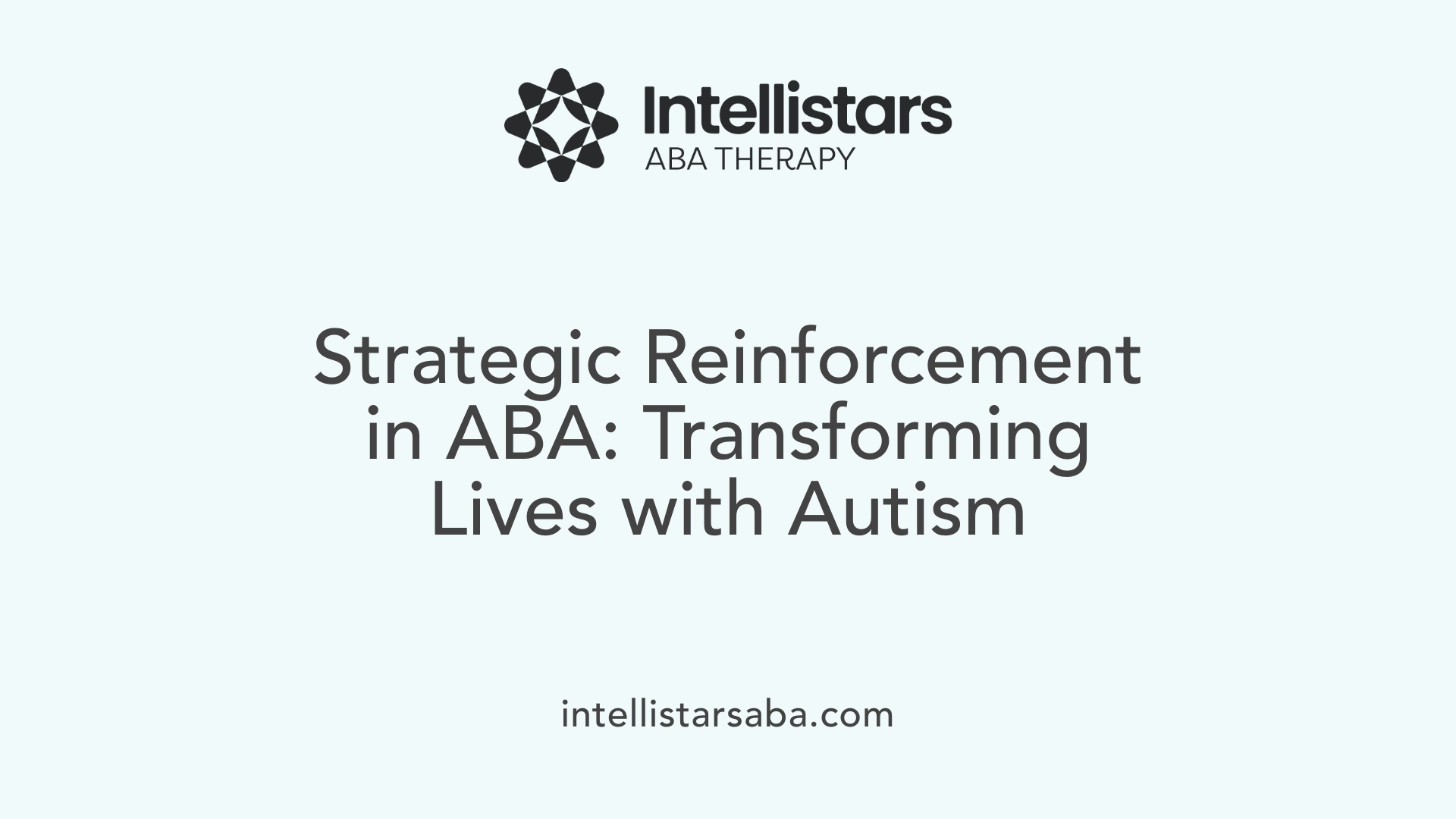
How Are Reinforcement Schedules Applied in ABA Therapy?
Applied Behavior Analysis (ABA) therapy uses reinforcement schedules strategically to encourage positive behavior change in individuals with autism. These schedules determine the timing and frequency of reinforcement, helping to shape and maintain desired behaviors effectively. For example, therapists may start with continuous reinforcement, rewarding every correct response to establish a new behavior.
What Role Do Reinforcement Schedules Play in Behavior Shaping and Maintenance?
Reinforcement schedules like fixed ratio (FR) and variable ratio (VR) are essential for sustaining behaviors over time. FR schedules reward after a set number of responses, encouraging high response rates but often leading to brief pauses after reinforcement. VR schedules provide reinforcement unpredictably after varying responses, which helps create persistent and steady behaviors, reducing the chances of extinction.
How Are Reinforcement Schedules Tailored to Individual Needs?
ABA providers customize reinforcement schedules based on the individual's learning pace, motivation, and specific goals. For instance, a variable interval (VI) schedule, which provides reinforcement after varying time intervals, can help promote steady behavioral responses without predictability. This customization enhances long-term effectiveness and engagement.
Who Typically Provides ABA Therapy for Individuals with Autism?
ABA therapy is typically delivered by trained professionals, including Board Certified Behavior Analysts (BCBAs), Registered Behavior Technicians (RBTs), and behavior therapists. BCBAs design and oversee individualized treatment plans, while RBTs often manage daily sessions under supervision. This collaborative approach ensures the reinforcement schedules are implemented correctly and adjusted as needed to meet each individual's unique requirements.
| Reinforcement Schedule | Description | Impact in ABA Therapy |
|---|---|---|
| Continuous | Reinforcement after every correct response | Effective for initial learning |
| Fixed Interval (FI) | Reinforcement after fixed time intervals | Produces scalloped responding and post-reinforcement pauses |
| Variable Interval (VI) | Reinforcement after varying time intervals | Encourages steady, consistent behavior |
| Fixed Ratio (FR) | Reinforcement after a set number of responses | High response rate with possible pauses |
| Variable Ratio (VR) | Reinforcement after varying number of responses | Highly persistent and steady behavior |
Maximizing Effectiveness: Choosing the Right Reinforcement Schedule
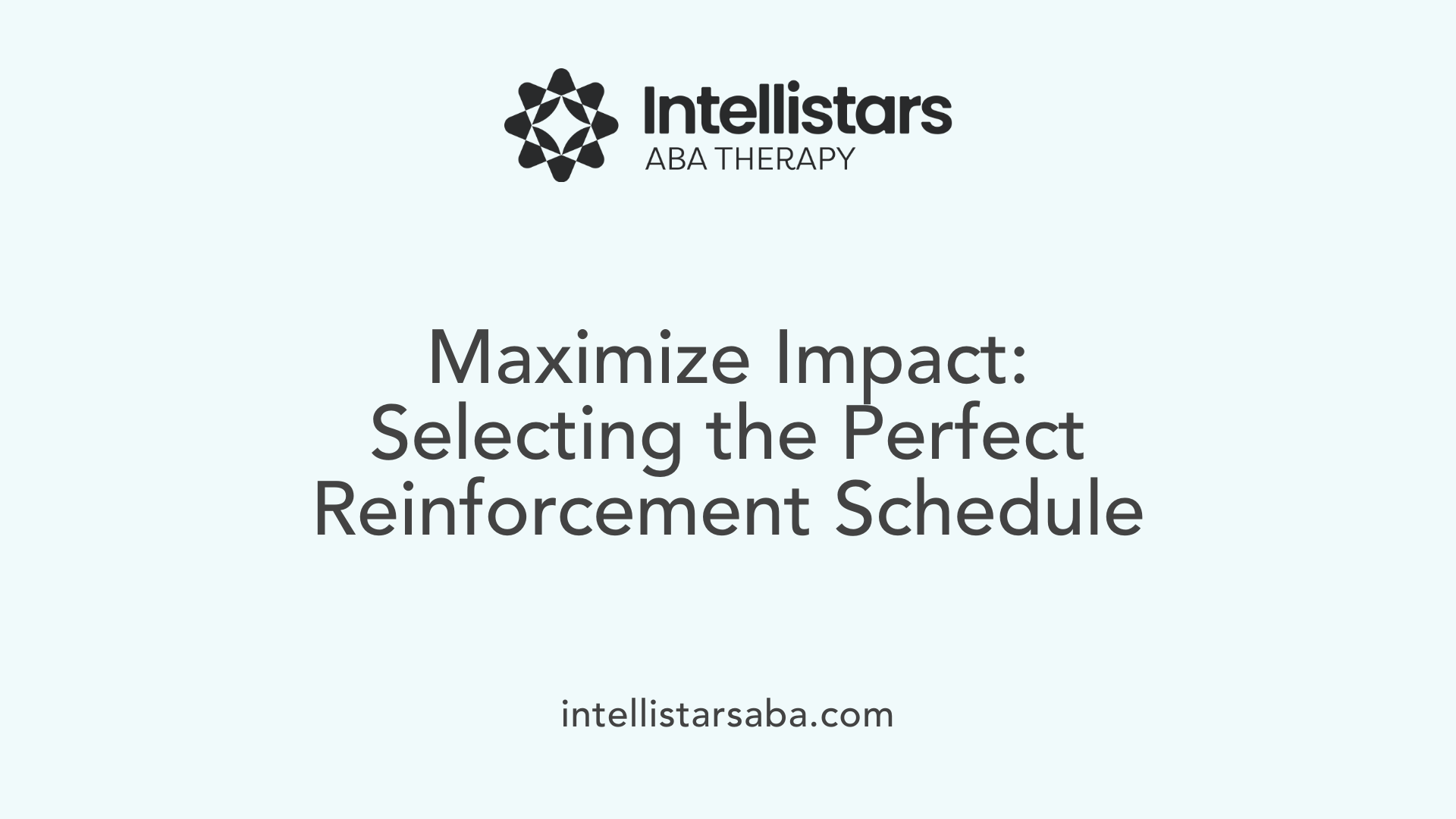
How to Select the Best Reinforcement Schedule for Behavior Change
Choosing an effective reinforcement schedule depends on the goals of the behavior modification program and the context in which it is applied. Key criteria include whether the aim is to establish a new behavior quickly or to maintain an existing behavior over time. For initial learning, continuous reinforcement—rewarding every correct response—is highly effective because it quickly builds the desired behavior. However, it carries a high risk of rapid extinction if the reinforcement stops.
For long-term behavior maintenance, intermittent reinforcement schedules such as variable ratio or variable interval are preferred. These schedules reward behavior unpredictably, which makes the behavior more resistant to extinction. Variable ratio schedules, for example, reward after a changing number of responses and encourage persistent, steady behavior, a pattern often seen in gambling. Variable interval schedules reinforce after unpredictable time periods, producing consistent and steady responses without pauses.
Balancing Rapid Acquisition and Resistance to Extinction
A practical approach involves starting with continuous reinforcement to establish the behavior. Once the behavior is well learned, transitioning to an intermittent schedule helps maintain it and reduces the chances that the behavior will diminish when reinforcement is less frequent.
Different types of intermittent schedules offer unique patterns of response. Fixed ratio schedules, rewarding after a set number of responses, generate rapid responses but often include a pause after reinforcement. Fixed interval schedules, where reinforcement is provided after specific time intervals, tend to create a "scalloped" response pattern with slower responses just after reinforcement but increasing activity as the reinforcement time approaches.
Applying Schedules to Sustain Long-Term Behavior
In settings like Applied Behavior Analysis (ABA) therapy for autism, selecting the appropriate schedule is crucial. Continuous reinforcement supports acquisition, while carefully managed variable schedules help sustain the child’s progress by encouraging consistent engagement over time. This balance ensures that behaviors are not only learned but also remain stable and resistant to extinction.
By understanding the strengths and limitations of each reinforcement schedule, practitioners can tailor behavior modification programs to optimize learning, sustain motivation, and promote durable behavior change.
Beyond Autism: Reinforcement Schedules in Diverse Settings
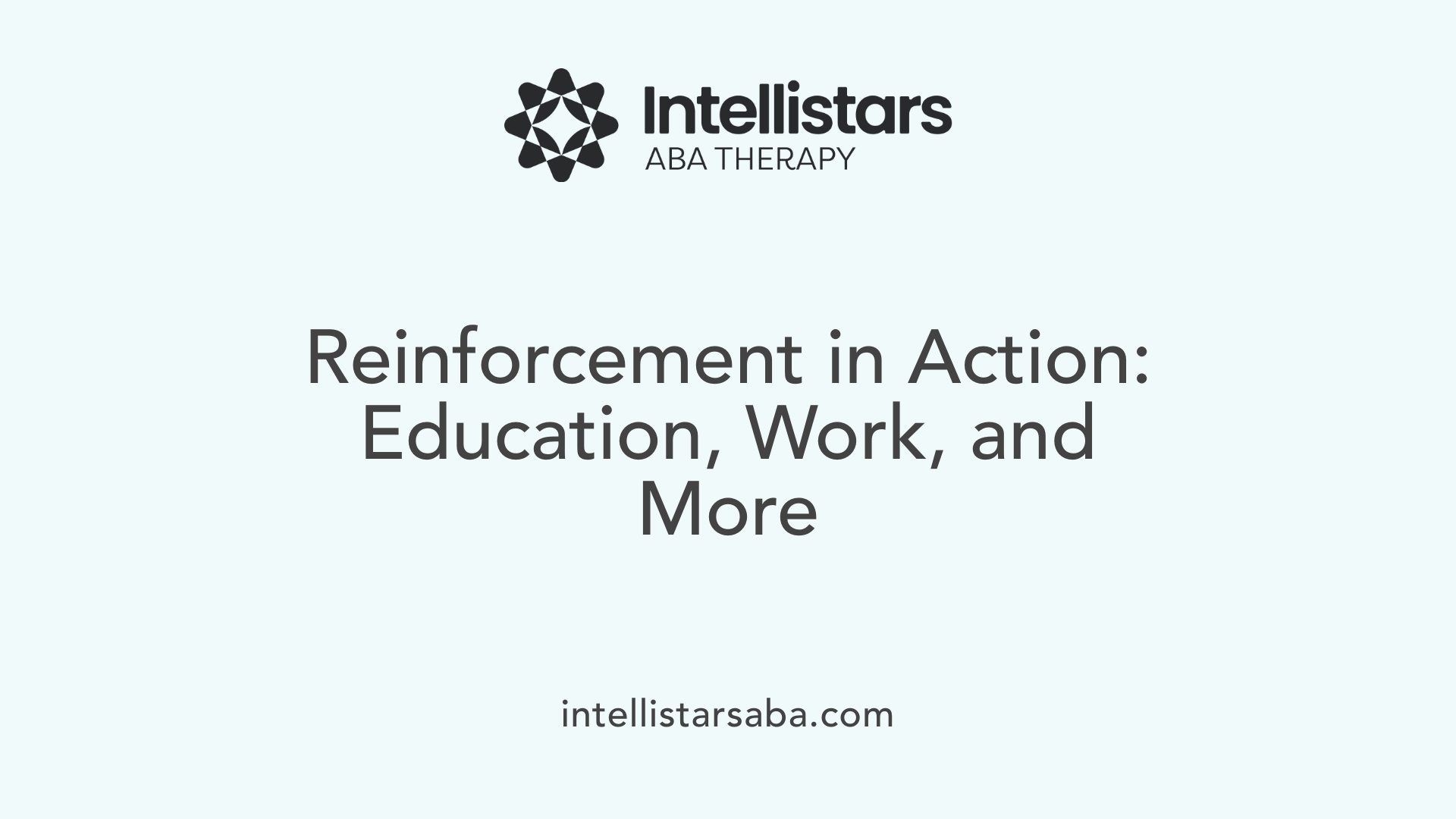
How Are Reinforcement Schedules Used in Education?
Reinforcement schedules are widely applied in educational settings to shape and maintain desired student behaviors and learning outcomes. Teachers often use continuous reinforcement when introducing new concepts or skills, providing immediate feedback or rewards for correct responses to encourage quick acquisition.
As learning progresses, intermittent reinforcement schedules—such as fixed ratio (reward after a set number of correct answers) or variable interval (unexpected praise during study sessions)—help sustain student engagement and motivation. Variable ratio schedules, for instance, can keep students consistently attentive by offering unpredictable rewards, preventing boredom or complacency.
What Role Do Reinforcement Schedules Play in Workplace Motivation?
In the workplace, reinforcement schedules contribute significantly to employee performance and satisfaction. Managers might use fixed interval schedules by providing bonuses or recognition at regular intervals (e.g., monthly performance reviews), which can motivate employees to maintain consistent effort.
Variable ratio schedules—like sales commissions or spot awards based on performance metrics—encourage persistent and high rates of productivity because employees are motivated to perform behaviors without knowing exactly when the reward will come. Fixed ratio systems, where rewards are tied to a specific number of completed tasks, also foster a high rate of output, usually combined with short breaks after rewards to maintain stamina.
How Do Reinforcement Schedules Facilitate General Behavior Modification?
Beyond specialized therapies like ABA for autism, reinforcement schedules are essential tools in general behavior modification practices. Whether encouraging healthy habits, reducing undesirable behaviors, or training animals, employing the appropriate reinforcement schedule optimizes results.
Continuous reinforcement is effective initially to establish a behavior, but intermittent schedules ensure long-term maintenance and resistance to extinction. For example, a variable interval schedule might reinforce regular exercise with occasional rewards, promoting a steady pattern without predictability that increases adherence.
In summary, tailoring reinforcement schedules to the context—education, workplace, or general behavior change—enhances effectiveness by shaping behavior patterns that are persistent, motivated, and adaptable to real-world environments.
Harnessing Reinforcement Schedules for Lasting Change
Reinforcement schedules form the backbone of effective behavior modification, providing structured yet flexible frameworks that guide how and when behaviors are rewarded. From the foundational principles established by Skinner to their tailored use in ABA therapy for autism, understanding these schedules empowers practitioners to shape, maintain, and strengthen behaviors with precision. Selecting the appropriate schedule is key to maximizing learning and sustaining progress, not only in therapeutic settings but also in education and workplace environments. As research continues to evolve, reinforcement schedules remain central to unlocking human potential and fostering meaningful, lasting behavioral change.
References
- Reinforcements and Scheduling in Operant Conditioning
- When to Use Schedules of Reinforcement in ABA for Shaping ...
- Understanding Reinforcement Schedules in Behavior ...
- How to Become an ABA Therapist - School of Education
- Types Of ABA Therapy Jobs And Their Degree Requirements
- Applied Behavior Analysis (ABA)
- Applied Behavior Analysis (ABA)
- The effectiveness of applied behavior analysis program ...
- The Top 10 Reasons Children With Autism Deserve ABA
- 6 Benefits of ABA Therapy for Children with Autism






